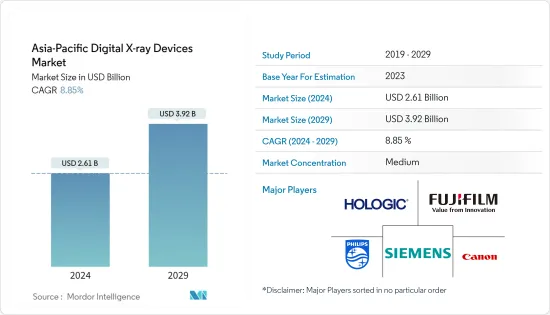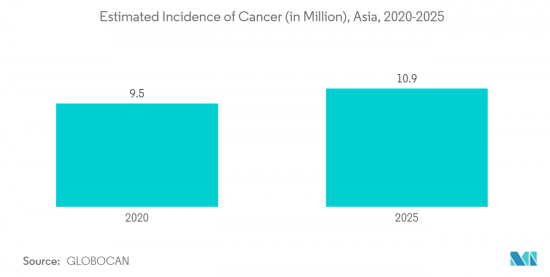PUBLISHER: Mordor Intelligence | PRODUCT CODE: 1403129

PUBLISHER: Mordor Intelligence | PRODUCT CODE: 1403129
Asia-Pacific Digital X-ray Devices - Market Share Analysis, Industry Trends & Statistics, Growth Forecasts 2024 - 2029

The Asia-Pacific Digital X-ray Devices Market size is estimated at USD 2.61 billion in 2024, and is expected to reach USD 3.92 billion by 2029, growing at a CAGR of 8.85% during the forecast period (2024-2029).
Key Highlights
- The COVID-19 pandemic turned the spotlight on diagnostic imaging, particularly on digital X-ray devices. Digital imaging played a key role in the diagnosis of COVID-19 and indicated the affected lung tissue in infected patients. Several key market players had focused on innovations in the production of radiography equipment and had launched products that proved important during the COVID-19 crisis. For instance, an article published in the Clinical Imaging Journal in January 2021 stated that chest computed tomography and digital radiography were extensively used as a definitive diagnosis and reexamination in the radiology department of Sichuan Provincial People's Hospital in China to cope with COVID-19.
- The studied market growth can largely be attributed to factors such as the increasing occurrence of orthopedic diseases and cancers, the increasing number of serious injuries, the advantages of digital X-ray systems over conventional X-rays, technological advancements, and product development.
- The major advantages of digital imaging are cost-effectiveness and easy accessibility. The hospitals can control their spending by lowering the cost of films, requiring less storage space and employing fewer staff to manage the services and archives. For instance, according to a December 2021 article in the Research (Wash D.C.) Journal, the development of computed radiography has sparked a technological advancement for digital X-ray imaging with more accurate and immediate information. Compared to traditional X-rays, digital X-rays expose patients to about 70% - 80% less radiation. The long-term health of patients will greatly benefit from this, especially pregnant women or patients who are already suffering from illness, thus ensuring safety. Therefore, the advantages provided by digital X-rays are estimated to propel the market growth during the forecast period.
- Also, due to the increase in the number of dental disorders, cardiac disorders, and cancers, especially breast cancer, there is an increased demand for digital ray devices globally. For instance, as per the Australian Bureau of Statistics article updated in March 2022, the prevalence of heart disease in Australia was 4.0%, representing one million people in 2021. Heart disease increased with age, from 2.3% of people aged 45-54 years to 23.2% of people aged 75 years and over.
- Also, as per World Health Organization's (WHO) October 2021 update, the prevalence of stroke is on the rise in India, with 18 lakh stroke cases annually. Such a high prevalence of cardiac disease among the population in the Asia-Pacific region reaped the demand for imaging devices with precise diagnosis, and hence, digital X-ray devices have acquired their importance in this context.
- Additionally, the advancements in technology and increasing product approvals, along with partnerships and collaborations by key players, are helping in the market growth. For instance, in June 2021, LG Electronics launched a digital X-ray detector (DXD) with artificial intelligence (AI) solutions to expand its presence in the medical equipment field. The company was expected to launch its new DXD in global markets, including South Korea. Such a launch of highly effective portable devices for imaging applications might, therefore, anticipate the demand for digital X-ray devices and drive market growth.
- Thus, the aforementioned factors, such as the high prevalence of cardiovascular diseases and technological advancements in digital x-ray products, are currently augmenting the growth of the digital X-ray devices market. However, the high installations and device costs, along with the rise in the use of refurbished devices, are expected to restrain the market growth.
Asia-Pacific Digital X-Ray Devices Market Trends
Portable Systems Segment is Expected to Hold a Significant Market Share Over The Forecast Period
- Portable X-ray has been a valuable tool for diagnosing and monitoring patients in the healthcare setting, where the transfer of patients to the radiology department is challenging. The portable X-ray machine has the potential to overcome location barriers and benefit patients who are in life-threatening situations and require immediate treatment wherever they are, possibly needing an on-the-spot diagnosis.
- As per an article published in the National Library of Medicine in October 2021, one significant benefit of using a portable X-ray is its ability to avoid transport and extra movements of patients. Radiograph examinations using mobile imaging equipment offer less processing speed and eliminate long wait times. Portable X-ray machines can take less than 20 minutes.
- Furthermore, portable X-ray devices offer potential socio-economic advantages by reducing the use of ambulance and taxi transportation, as well as personnel pull-out to accompany the patients to and from the hospital. Mobile X-rays help reduce overall costs. Hence, the advantages associated with portable X-ray is expanding the product demand.
- The new launches are further propelling the market growth. For instance, in July 2022, Shimadzu Corporation added a new MobileDaRt Evolution MX8 Version v type digital mobile X-ray system to the mobile X-ray system lineup for release outside Japan. The system incorporates digital radiography (DR), which is in demand outside Japan. With the advantages of portable systems and increasing product launches, the segment is expected to grow significantly over the forecast period.
- Hence, owing to the aforementioned factors, such as the advantages of portable X-ray devices and rising product launches, the segment is believed to witness rapid growth over the forecast period.

India is Expected to Hold a Significant Share in the Digital X-ray Devices Market Over The Forecast Period
- India is expected to hold a significant share of the digital X-ray devices market mainly because of the rising geriatric population, the high burden of orthopedic and dental diseases, and the rising product launches.
- The geriatric population is prone to orthopedic, dental, and other diseases. Digital x-ray devices are highly beneficial for this population because of the difficulty of commute. For instance, according to the United Nations Population Fund dashboard statistics updated in 2022, an estimated 7% of India's total population was 65 years or older in 2022.
- Also, according to the National Statistical Office (NSO)'s Elderly in India 2021 report published in August 2021, India's elderly population (aged 60 and above) was projected to reach from 138 million in 2021 to 194 million in 2031. Hence, the high burden of the geriatric population is expected to expand the market growth during the forecast period.
- Furthermore, investments in medical devices are increasing in India, which is anticipated to create opportunities for growth in the digital X-ray devices market. The India Brand Equity Foundation December 2021 update reported that the Indian medical device market growth is mostly driven by 75-80% imports from countries such as the United States, China, and Germany. In addition, in recent times, exports have seen a surge in demand. The 'Atma Nirbhar' Bharat mission is providing momentum to India's vision of becoming a global manufacturing hub for medical devices. This is expected to fuel India's digital x-ray devices market growth during the forecast period.
- The local market players are investing heavily in product development and launches to boost digital X-ray device manufacturing in India. For Instance, in March 2021, Fujifilm India Pvt. Ltd launched FDR Micro, a portable digital radiology system. This revolutionary digital radiology technology provides noise reduction circuits, which in turn increases the granularity of low-density zones and achieves good image quality. It offers high-resolution imaging with minimal X-ray doses in healthcare settings.
- Therefore, the aforementioned factors, such as the rising geriatric population, increasing government initiatives to expand the manufacturing of medical devices, including digital X-ray devices, and product launches, are anticipated to propel the market growth in the country.
Asia-Pacific Digital X-Ray Devices Industry Overview
The market is moderately consolidated in nature due to the presence of several market players. The major players have established themselves in specific segments of the market. Furthermore, the companies are competing in emerging regions with global players and with established local players. Key players are developing and launching novel products and technologies to compete with existing products, while others are acquiring and partnering with other companies trending in the market. The global players in the Asia-Pacific digital X-ray devices are Canon Inc., Koninklijke Philips N.V. (Carestream Health Inc.), Fujifilm Holdings Corporation, GE Healthcare, Hologic Inc., Koninklijke Philips N.V, Samsung Electronics (Samsung Medison Co., Ltd.), Shimadzu Corporation, Siemens AG.
Additional Benefits:
- The market estimate (ME) sheet in Excel format
- 3 months of analyst support
TABLE OF CONTENTS
1 INTRODUCTION
- 1.1 Study Assumptions and Market Definition
- 1.2 Scope of the Study
2 RESEARCH METHODOLOGY
3 EXECUTIVE SUMMARY
4 MARKET DYNAMICS
- 4.1 Market Overview
- 4.2 Market Drivers
- 4.2.1 Rising Burden of Diseases Requiring Diagnosis
- 4.2.2 Advantages over Conventional X-rays and Technological Advancements
- 4.3 Market Restraints
- 4.3.1 High Cost Associated with Device Installation
- 4.4 Porter's Five Forces Analysis
- 4.4.1 Threat of New Entrants
- 4.4.2 Bargaining Power of Buyers/Consumers
- 4.4.3 Bargaining Power of Suppliers
- 4.4.4 Threat of Substitute Products
- 4.4.5 Intensity of Competitive Rivalry
5 MARKET SEGMENTATION (Market Size by Value - USD)
- 5.1 By Portability
- 5.1.1 Fixed Systems
- 5.1.2 Portable Systems
- 5.2 By Application
- 5.2.1 Orthopedic
- 5.2.2 Chest Imaging
- 5.2.3 Dental
- 5.2.4 Other Applications
- 5.3 By End-User
- 5.3.1 Hospitals
- 5.3.2 Diagnostic Centers
- 5.3.3 Other End-Users
- 5.4 Geography
- 5.4.1 China
- 5.4.2 Japan
- 5.4.3 India
- 5.4.4 Australia
- 5.4.5 South Korea
- 5.4.6 Rest of Asia-Pacific
6 COMPETITIVE LANDSCAPE
- 6.1 Company Profiles
- 6.1.1 Canon Inc.
- 6.1.2 Koninklijke Philips N.V. (Carestream Health Inc.)
- 6.1.3 Fujifilm Holdings Corporation
- 6.1.4 GE Healthcare
- 6.1.5 Hologic, Inc.
- 6.1.6 Samsung Electronics (Samsung Medison Co., Ltd.)
- 6.1.7 Shimadzu Corporation
- 6.1.8 Siemens AG
7 MARKET OPPORTUNITIES AND FUTURE TRENDS




